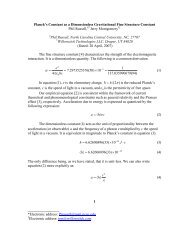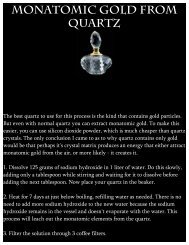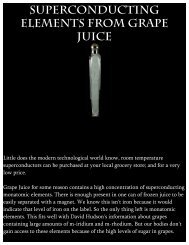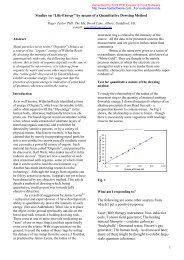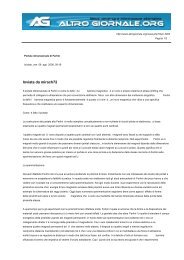Viktor Schauberger
Viktor Schauberger
Viktor Schauberger
You also want an ePaper? Increase the reach of your titles
YUMPU automatically turns print PDFs into web optimized ePapers that Google loves.
Due to round-the-clock bombing the SS was forced to try even more drastic measures, launching<br />
unmanned interceptor discs from the Schwarzwald. These discs were known as the "Feuerball"<br />
weapon, sometimes erroneously referred to as the mystery "V-7" weapon (of which there never was an<br />
official designation). The WNF Feuerball relied on a rocket motor for launch, a plume sensor for aerial<br />
detection, and an electrostatic filed weapon invented at Messerschmitt’s Oberammergau facility.<br />
Production of these craft was initially performed by WNF. Because the discs burned chemicals around<br />
its ring to create the electrostatic field necessary to disable Allied bomber engines and radar the object<br />
was soon nicknamed the "Foo Fighter" by the Allies who sighted this fiery halo weapon approaching<br />
them by day or night. FOO was a take on the French word Feu (Fire) and from the Smokey Stover<br />
comic of a bumbling fireman that actually started fires!<br />
Naturally, WNF observed the burning effect too and soon nicknamed their weapon the WNF Feuerball<br />
(Fireball). The Feuerballs plagued the 415th NFS from November 1944 to April 1945. By that time<br />
production had been shifted to the Zeppelin Werk that nicknamed the larger improved weapon as<br />
"Kugelblitz" (Ball Lightning). The Allies seemed confused by these weapons which ranged in size from<br />
small to large and attacked in singles or multiples. The Germans further confused the Allies by launching<br />
"Seifenblasen" along with the Feuerballs. Seifenblasen (Soap Bubbles) were large weather balloons<br />
trailing metal strips that confused Allied radar. Their large round shape reflecting in daylight gave them<br />
the appearance of a shining globe similar to the Feuerball. The Germans further complicated the<br />
identification of the "Foo Fighters" with a range of smaller purely spherical aerial probes that were used<br />
as psychological weapons. These "KugelWaffen" (Ball weapons) played aerial games with the Allied<br />
bomber gunners that would have in time distracted them from the real threat of larger approaching<br />
Kugelblitz discs.<br />
But by the spring of 1945 the war was lost regardless and most of the remaining disc programs were<br />
halted. Henri Coanda had been arrested in Paris in 1940 and forced to work on a disc under SS<br />
supervision. His design for a lenticular disc that benefited from his own "Coanda effect" was a<br />
masterpiece of jet disc design. But because it required 12 JUMO 004 jets to power the huge machine<br />
the project never got past the wind tunnel testing phase. Likewise, Andreas Epps independent Omega<br />
Diskus which utilized two Pabst ramjets and 8 Argus lift fans was also confined to 1/10th scale model<br />
testing.<br />
Dr. Alexander Lippisch had also studied disc aerodynes back in 1941 but was too involved in the ME-<br />
163 Komet and DM-1 delta glider programs to produce anything more than brief design concepts based<br />
on the Gottingen K 1253 disc wing profile. The Horten brothers, experts with flying wings, also studied<br />
circular wing designs but did not actually work on any in Nazi Germany. They did so for the US Govt.



